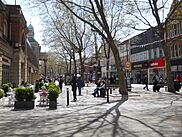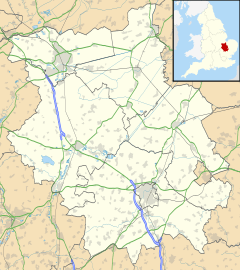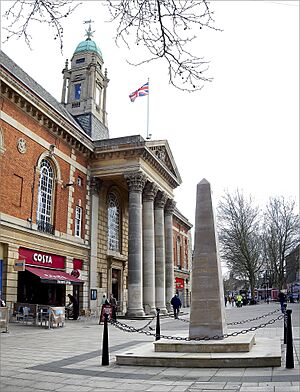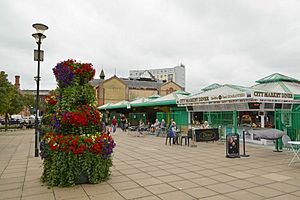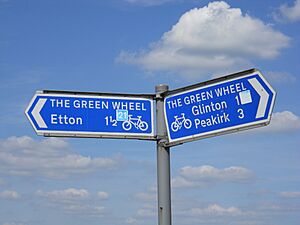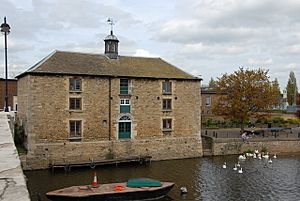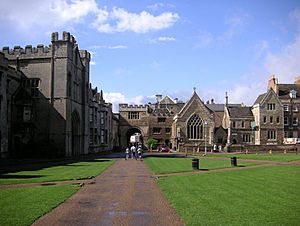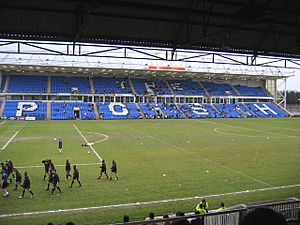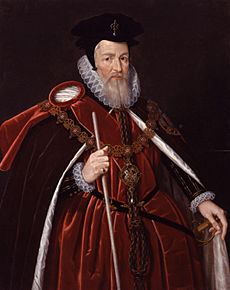Peterborough facts for kids
Quick facts for kids Peterborough |
|
|---|---|
| City | |
| Population | 215,673 (2021) |
| OS grid reference | TL 19204 98638 |
| Unitary authority |
|
| Shire county | |
| Region | |
| Country | England |
| Sovereign state | United Kingdom |
| Post town | PETERBOROUGH |
| Postcode district | PE1–PE8 |
| Dialling code | 01733 |
| Police | Cambridgeshire |
| Fire | Cambridgeshire |
| Ambulance | East of England |
| EU Parliament | East of England |
| UK Parliament |
|
Peterborough is a city in Cambridgeshire, England. It's about 74 miles (119 km) north of London, located on the River Nene. In 2021, the city had a population of 192,178 people.
People have lived in this area since before the Bronze Age. You can see proof of this at the Flag Fen site. The Romans also lived here a long time ago. Later, in the Anglo-Saxon period, a monastery was built. This monastery eventually became the famous Peterborough Cathedral.
In the 1800s, the city grew quickly when the railway arrived. Peterborough became known for making bricks and for its engineering companies. After World War II, many factory jobs disappeared. But in the 1960s, Peterborough was named a "new town" to help it grow again. Today, the main jobs are in financial services and distribution.
Peterborough is a "cathedral city" because it has a large cathedral. The land around Peterborough is very flat. Some areas are even below sea level!
Contents
- Peterborugh's Past: A Look at History
- How Peterborough is Run: Governance
- Peterborough's Economy and Jobs
- Getting Around: Transport
- People of Peterborough: Demography
- Fun and Learning: Culture
- Famous Places: Landmarks
- Famous People from Peterborough
- Peterborough's Location and Climate
- Freedom of the City
- Images for kids
- See also
Peterborugh's Past: A Look at History
How Peterborough Got Its Name
The town was first called Medeshamstede. In the late 900s, its name changed to Burgh. This might have happened after Abbot Kenulf built a wall around the abbey, which was dedicated to Saint Peter. Over time, this name became Peterborough.
Ancient Times and Early Settlements
People have lived in the Peterborough area for thousands of years. This is because the River Nene created dry land in The Fens, which was good for living. You can see signs of Iron Age settlements at the Flag Fen site.
The Romans built a fortified town called Durobrivae about 5 miles (8 km) west of the city. They also had a large fort at Longthorpe for about 3,000 soldiers. Peterborough was important for making Roman pottery. This pottery was traded far and wide!
Around 655 AD, a monastery was founded in the area. It was built by Sexwulf on land given by Peada of Mercia.
Medieval Times and the Abbey
In 1069 or 1070, a famous outlaw named Hereward the Wake caused trouble in the town. The abbey church was rebuilt and made much bigger in the 1100s. Monks at the abbey wrote the Peterborough Chronicle. This book tells us unique things about English history after the Norman Conquest.
The abbey church became one of Henry VIII's cathedrals in 1541. This meant it was no longer just an abbey but also a major church for a bishop.
Civil War and Later History
During the English Civil War in the 1600s, Peterborough was divided. Some people supported King Charles I, and others supported Parliament. In 1643, Parliamentary soldiers came to Peterborough. They damaged the cathedral, destroying parts of it and many old records.
The city used to have special rights, like holding its own fairs. One of these, the Bridge Fair, still happens today. The mayor leads a procession and reads a special announcement to open the fair.
Modern Growth and Development
The arrival of the Great Northern Railway in the 1850s changed Peterborough a lot. It turned the city from a market town into an industrial center. Because of the railway and lots of local clay, Peterborough became a huge brick-making area. For much of the 1900s, it was the UK's top brick producer.
Companies like Perkins Engines (started in 1932) and Baker Perkins became major employers. They made diesel engines and industrial machines.
In 1967, Peterborough was chosen as a "New Town". This meant it would grow to house people from London. New areas like Bretton and Orton were built. The city also got a big indoor shopping center called Queensgate, which opened in 1982. Many new roads, called parkways, were also built to help with traffic.
Peterborough's population grew a lot between 1971 and 1991. New companies in financial services moved in, changing the types of jobs available. The city continues to grow and develop. Recent projects include Fletton Quays, which has new apartments, offices, and a hotel.
How Peterborough is Run: Governance
Peterborough is run by one main local government body called Peterborough City Council. This council meets at the Peterborough Town Hall. The city council is also part of the Cambridgeshire and Peterborough Combined Authority. This larger group is led by the Mayor of Cambridgeshire and Peterborough.
The area managed by the city council is called the Peterborough district. This district includes not just the city itself but also many nearby villages and rural areas. Peterborough officially has "city status" because of this district.
A Brief Look at Administrative History
Peterborough was once an "ancient parish" in Northamptonshire. It was divided into smaller areas. When the abbey church became Peterborough Cathedral in 1541, Peterborough was then considered a city.
In 1874, Peterborough became a "municipal borough" with its own elected council. In 1974, this borough was changed, and Peterborough became part of Cambridgeshire. Since 1998, Peterborough has been a "unitary authority". This means it manages its own local services, separate from the main Cambridgeshire county council.
Peterborough's Economy and Jobs
Growing the Economy
Peterborough's economy has grown very successfully. It has a strong focus on environmental businesses. In fact, it has the largest group of environmental companies in the UK.
In 1994, Peterborough declared itself one of four "environment cities" in the UK. The goal was to become the country's leading environmental capital. An independent charity, Peterborough Environment City Trust (PECT), helps achieve this goal. They run projects that encourage healthy and sustainable living.
Jobs in the City
Many people who work in Peterborough also live there. However, some people travel into the city for work, and others travel out. Earnings in Peterborough are a bit lower than the average for the East of England.
The city plans to create many new jobs as its population grows. These jobs will be in retail, leisure, hotels, and offices. Large companies like Tesco and Debenhams have distribution centers here, creating many jobs.
Peterborough has always had low unemployment. This makes it a popular place for people to move for work. Many people have moved here from other countries, especially from European Union countries that joined in 2004. To handle this growth, the council plans to build many new homes each year.
Getting Around: Transport
Train Travel
Peterborough railway station is a major stop on the East Coast Main Line. You can get to central London in about 45-50 minutes from here. High-speed trains run regularly to London and Edinburgh.
Peterborough is also a big railway junction. Many other train lines meet here. You can catch trains to places like Norwich, Nottingham, Liverpool, Leicester, Birmingham, and Stansted Airport.
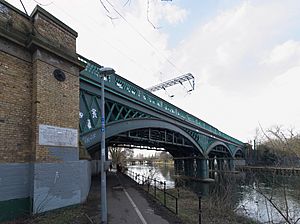
Waterways
The River Nene flows through the city center. It was made navigable for boats in 1761. The Nene Viaduct carries the railway over the river. This bridge was built in 1847 and is the oldest surviving cast iron railway bridge in the UK.
The Customs House, an old building by the Town Bridge, reminds us that Peterborough used to be an important inland port.
Roads and Buses
The A1/A1(M) is a major road that passes Peterborough. It broadly follows the old Great North Road from London to Edinburgh.
Peterborough used to have a tramway system, but it was replaced by buses in 1930. Today, several companies operate bus services in the city. Even with its growth, Peterborough has good travel times for a city its size. This is thanks to the network of high-speed roads called parkways.
Green Wheel and Cycling
The Peterborough Millennium Green Wheel is a 50-mile (80 km) network of paths for cycling, walking, and horse riding. These paths go all around the city, with routes connecting to the city center. The project also includes sculptures and local landscape features like mini woodlands.
Another long-distance path, the Hereward Way, also passes through Peterborough. Cycling has become more popular in the city, with new cycle lanes being added.
People of Peterborough: Demography
Population Growth
The Peterborough local authority area has a population of about 215,700 people. It is expected to grow to 230,000 by 2031. Peterborough's population growth has been one of the fastest in Britain. This is partly due to people moving here from other countries.
| Year | Population |
|---|---|
| 1901 | 46,986 |
| 1911 | 53,114 |
| 1921 | 58,186 |
| 1931 | 63,745 |
| 1939 | 69,855 |
| 1951 | 76,555 |
| 1961 | 89,794 |
| 1971 | 105,323 |
| 1981 | 131,696 |
| 1991 | 155,050 |
| 2001 | 156,060 |
| 2011 | 183,600 |
| 2021 | 215,700 |
Different Backgrounds
According to the 2011 census, most of Peterborough's residents (82.5%) are white. There are also significant Asian (11.7%) and Black (2.3%) communities.
Peterborough has one of the largest groups of Italian immigrants in the UK. Many Italians came here in the 1950s to work for the London Brick Company. By 1996, it was estimated that about 7,000 Italians lived in Peterborough.
In recent years, many people have moved to Peterborough from countries that joined the European Union in 2004. This has made the city even more diverse. Many different languages are now spoken in Peterborough.
Faith and Beliefs
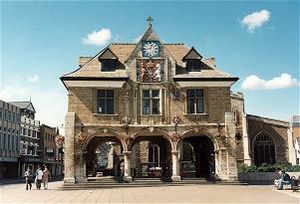
Christianity is the largest religion in Peterborough, especially the Church of England. The city has many churches and, of course, the cathedral. The number of Roman Catholic people has also grown a lot due to recent immigration.
Peterborough has a higher percentage of Muslims than the rest of England. Most Muslims live in the Millfield, West Town, and New England areas, where there are two large mosques. The city also has Hindu and Sikh temples.
The Anglican Diocese of Peterborough covers a large area, including all of Northamptonshire and Rutland. The parts of the city south of the river are in the Diocese of Ely. The Roman Catholic Diocese of East Anglia covers all of Peterborough.
Fun and Learning: Culture
Schools and Colleges
Peterborough has one independent boarding school, The Peterborough School. It teaches students up to age 18. Many of the city's state secondary schools have changed recently. Some old schools were replaced by new ones, like the Thomas Deacon Academy, which opened in 2007.
The King's School is one of seven schools created by King Henry VIII. It was meant to pray for his soul after he closed the monasteries.
The city has two colleges for further and higher education: Peterborough College and City College Peterborough. A new university campus, ARU Peterborough, opened in September 2022. It is part of Anglia Ruskin University and offers courses in business, arts, environment, and health.
The main public library on Broadway was funded by Andrew Carnegie and opened in 1906.
Arts and Entertainment
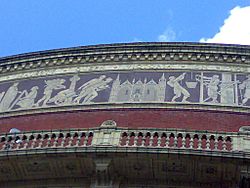
Peterborough hosts many events, including the annual East of England Show and the CAMRA beer festival. These festivals help support local artists and community projects.
The city has a strong visual arts community. You can see sculptures by the famous artist Antony Gormley on top of buildings around Cathedral Square.
The Key Theatre, built in 1973, is located by the River Nene. It offers a variety of shows, including plays, comedy, and music. The old Odeon Cinema on Broadway, which closed in 1991, was damaged by fire but plans are in place for its future. The Embassy Theatre, another old cinema, is now a bar.
The John Clare Theatre inside the new central library shows films. The Cresset in Bretton is another popular venue for theatre, comedy, and music. Peterborough also has a 13-screen Showcase Cinema, an ice rink, and two indoor swimming pools.
You can find many different types of restaurants in the city, including Chinese, Indian, Thai, and Italian. Peterborough has also been featured in several popular books and films.
Sports in Peterborough
Peterborough United Football Club, nicknamed "The Posh," has been the local football team since 1934. They play their home games at London Road. The team is known for its exciting matches and once set a record for the most goals in a season in 1960–61.
Besides football, Peterborough has teams for rugby, cricket, hockey, ice hockey, rowing, and athletics. The Peterborough City Rowing Club holds regattas that attract rowers from all over the country. The Great Eastern Run, a half-marathon, also takes place here.
The Peterborough Phantoms are the city's ice hockey team. Motorcycle speedway is also popular, with races held at the East of England Showground. The team is called the Peterborough Panthers. Peterborough has also hosted rounds of the Tour Series, a cycling race series.
In recent years, bandy (a sport similar to ice hockey) has started in Peterborough. The Peterborough Bandy Club was founded in 2018.
Media and Entertainment
Peterborough has several radio stations. BBC Radio Cambridgeshire covers the city, and there are local community stations like Salaam FM and Peterborough Community Radio (PCR FM).
The Peterborough Telegraph is the city's newspaper. Its website, Peterborough Today, is updated daily.
Peterborough has been used as a filming location for TV shows and movies. Parts of The Barchester Chronicles (1982) and the James Bond films Octopussy (1983) and GoldenEye (1995) were filmed here. Even a music video for the band Queen was shot on the Nene Valley Railway.
Famous Places: Landmarks
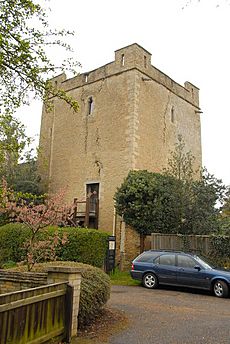
Peterborough Cathedral is a very old and important building. It was first a monastery in 655 AD and rebuilt between 1118 and 1238. It's famous for its large, impressive West Front with three huge arches. Two queens were once buried here: Catherine of Aragon and Mary, Queen of Scots.
The city's layout was planned by Abbot Martin de Vecti in the 1100s. He created the market place and the wharf by the river. Peterborough's 17th-century Guildhall was built in 1671. It stands on columns, which used to be an open space for markets.
Peterscourt on City Road was designed in 1864. Nearby, Tout Hill is the site of an old castle. The city has a large Victorian park called The Park, with gardens, play areas, and tea rooms. The Lido, an outdoor swimming pool with art deco design, opened in 1936 and is still used today.
Peterborough Museum and Art Gallery, built in 1816, has a huge collection of objects. These include local archaeology, Roman pottery, and marine fossils. It also has writings by the poet John Clare and items made by French prisoners of war from the Norman Cross Prison.
Burghley House, north of Peterborough, is a beautiful 16th-century country house. It was designed by Sir William Cecil. The estate hosts the Burghley Horse Trials every year. Another historic home, Milton Hall, also dates from the same period.
The John Clare Cottage in Helpston is where the poet John Clare was born. It has been restored to show how people lived in the early 1800s.
Longthorpe Tower, a 14th-century tower and fortified house, is about 2 miles (3 km) west of the city center. It has amazing old paintings inside. Nearby Thorpe Hall is now a hospice.
Flag Fen, the Bronze Age archaeological site, was found in 1982. It has many ancient poles that connected Whittlesey with Peterborough across the wet fenland. The museum at the site shows many items found there, including what might be Britain's oldest wheel.
The Nene Valley Railway is a 7.5-mile (12 km) heritage railway. It runs from the city center to Yarwell Junction. Railworld is a railway museum next to the station.
Nene Park, which opened in 1978, is a large park with three lakes. Ferry Meadows is a popular part of Nene Park.
Southey Wood is a mixed woodland. Nearby nature reserves like Castor Hanglands and Barnack Hills and Holes are important wildlife sites.
Famous People from Peterborough
Many notable people were born in Peterborough or lived here. These include:
- George Alcock, a famous astronomer who discovered many novas and comets.
- John Clare, a 19th-century poet from Helpston.
- Sir Henry Royce, co-founder of Rolls-Royce.
- Hereward the Wake, an outlaw who fought against the Norman Conquest.
- Saint John Payne, a Catholic martyr.
Musicians from Peterborough include:
- Andy Bell, lead singer of Erasure.
- Maxim Reality and Gizz Butt from The Prodigy.
- Aston Merrygold from the pop group JLS.
Other famous people include:
- Actors Simon Bamford and Luke Pasqualino.
- TV presenters Sarah Cawood and Jake Humphrey.
- Peter Boizot, who founded the Pizza Express restaurant chain.
In sports, famous people from Peterborough include:
- Footballer David Bentley.
- Gymnast Louis Smith, who won an Olympic medal.
- Footballer Isaiah Brown.
- Rugby player Harry Wells.
Peterborough's Location and Climate
Weather in Peterborough
Peterborough has a maritime climate, which means it has relatively cool summers and mild winters. Compared to other parts of the UK, East Anglia is a bit warmer and sunnier in summer, and colder and frostier in winter.
Cambridgeshire is one of the driest counties in the UK, getting about 600 mm (24 inches) of rain each year. The highest temperature recorded near Peterborough was 39.9°C (103.8°F) in July 2022. The lowest was -13.9°C (7.0°F) in February 1986.
| Climate data for Wittering, elevation: 73 m (240 ft), 1991–2020 normals, extremes 1957–present | |||||||||||||
|---|---|---|---|---|---|---|---|---|---|---|---|---|---|
| Month | Jan | Feb | Mar | Apr | May | Jun | Jul | Aug | Sep | Oct | Nov | Dec | Year |
| Record high °C (°F) | 15.1 (59.2) |
17.8 (64.0) |
23.1 (73.6) |
26.3 (79.3) |
27.6 (81.7) |
33.3 (91.9) |
39.9 (103.8) |
35.2 (95.4) |
31.0 (87.8) |
28.2 (82.8) |
17.5 (63.5) |
15.5 (59.9) |
39.9 (103.8) |
| Mean daily maximum °C (°F) | 7.1 (44.8) |
7.9 (46.2) |
10.4 (50.7) |
13.4 (56.1) |
16.5 (61.7) |
19.5 (67.1) |
22.1 (71.8) |
21.7 (71.1) |
18.7 (65.7) |
14.4 (57.9) |
10.1 (50.2) |
7.4 (45.3) |
14.1 (57.4) |
| Daily mean °C (°F) | 4.3 (39.7) |
4.6 (40.3) |
6.6 (43.9) |
9.0 (48.2) |
11.9 (53.4) |
14.9 (58.8) |
17.2 (63.0) |
17.0 (62.6) |
14.5 (58.1) |
10.9 (51.6) |
7.1 (44.8) |
4.6 (40.3) |
10.2 (50.4) |
| Mean daily minimum °C (°F) | 1.5 (34.7) |
1.4 (34.5) |
2.7 (36.9) |
4.6 (40.3) |
7.4 (45.3) |
10.3 (50.5) |
12.3 (54.1) |
12.3 (54.1) |
10.2 (50.4) |
7.4 (45.3) |
4.0 (39.2) |
1.8 (35.2) |
6.4 (43.5) |
| Record low °C (°F) | −13.9 (7.0) |
−13.5 (7.7) |
−12.0 (10.4) |
−5.5 (22.1) |
−1.3 (29.7) |
0.8 (33.4) |
5.2 (41.4) |
4.8 (40.6) |
1.0 (33.8) |
−3.9 (25.0) |
−7.6 (18.3) |
−10.9 (12.4) |
−13.9 (7.0) |
| Average precipitation mm (inches) | 47.0 (1.85) |
38.9 (1.53) |
39.0 (1.54) |
44.2 (1.74) |
49.6 (1.95) |
52.9 (2.08) |
55.5 (2.19) |
59.9 (2.36) |
52.9 (2.08) |
63.3 (2.49) |
57.5 (2.26) |
53.0 (2.09) |
613.6 (24.16) |
| Average precipitation days (≥ 1.0 mm) | 10.1 | 9.3 | 8.7 | 8.8 | 8.4 | 9.0 | 9.1 | 9.2 | 8.3 | 10.2 | 11.2 | 10.7 | 113.1 |
| Mean monthly sunshine hours | 63.4 | 86.2 | 124.8 | 167.9 | 204.9 | 195.3 | 207.1 | 192.9 | 151.8 | 113.0 | 73.7 | 64.2 | 1,645.1 |
| Source 1: Met Office | |||||||||||||
| Source 2: Starlings Roost Weather | |||||||||||||
Flat Land and Fenland
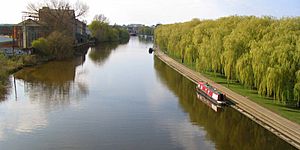
East Anglia is known for being very flat. Much of Cambridgeshire is low-lying, and some parts are even below sea level. The lowest point in England is near Peterborough, at Holme Fen, which is 2.75 meters (9 feet) below sea level.
Peterborough is often called the Gateway to the Fens. Before they were drained, the Fens were often flooded. This meant that farming was limited to higher areas. Today, thanks to modern drainage, the Fens are mostly used for growing crops.
The Peterborough district extends beyond the city itself. It includes villages to the north-west and north-east, and the Ortons south of the River Nene. It borders Northamptonshire, Lincolnshire, and other parts of Cambridgeshire.
Urban Areas
- Bretton
- Dogsthorpe
- Eastfield
- Eastgate
- Fengate
- Fletton
- Gunthorpe
- The Hamptons
- Longthorpe
- Millfield
- Netherton
- Newark
- New England
- The Ortons
- Parnwell
- Paston
- Ravensthorpe
- Stanground
- Walton
- Werrington
- West Town
- Westwood
- Woodston
Rural Areas
- Ailsworth
- Bainton
- Barnack
- Borough Fen
- Castor
- Deeping Gate
- Etton
- Eye
- Eye Green
- Glinton
- Helpston
- Marholm
- Maxey
- Newborough
- Northborough
- Peakirk
- Southorpe
- St. Martin's Without
- Sutton
- Thorney
- Thornhaugh
- Ufford
- Upton
- Wansford
- Wittering
- Wothorpe
City Connections: Affiliations
Town twinning began in Europe after World War II to promote friendship between different cities. Peterborough is twinned with several cities around the world:
- Alcalá de Henares, Spain (since 1986)
- Ballarat, Australia (since 1947)
- Bourges, France (since 1957)
- Forlì, Italy (since 1981)
- Viersen, Germany (since 1981)
- Vinnytsia, Ukraine (since 1991)
Peterborough also has friendly links with other places like Foggia, Italy, and Kwe Kwe, Zimbabwe.
Freedom of the City
The "Freedom of the City" is a special honor given to people, military units, or groups. It's the highest award a city can give. Here are some who have received it in Peterborough:
Individuals
- Peter Boizot: 2007
- Wyndham Thomas, British architect: 19 September 2015
- Louis Smith: 21 March 2017
- James Fox: 21 March 2017
- Lee Manning: 21 March 2017
- Tommy Robson: 12 March 2020
Military Units
- RAF Wittering: 1983
- 158 (Royal Anglian) Transport Regiment, Royal Logistic Corps (Volunteers): 25 July 2009
- 115 (Peterborough) Squadron Air Training Corps: 28 April 2014
Organizations and Groups
- The Salvation Army (Peterborough Branch): 4 March 2015
- Royal British Legion (Peterborough Branch): 28 July 2021
Images for kids
-
Peterborough Cathedral (1118–1375), with its Early English Gothic west front
-
Burghley House (1555–1587), home of the Marquess of Exeter
See also
 In Spanish: Peterborough para niños
In Spanish: Peterborough para niños



